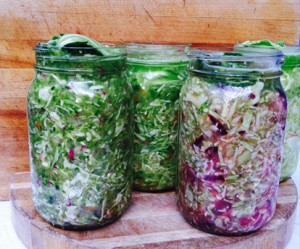Miracle Food
Fermentation happens continuously in nature—glucose, that is present in organic substances (food), is converted into energy required by living cells. The process is referred to as ‘oxidative decomposition’ or glycolysis and is a bio-chemical activity brought about by specific agents, enzymes and/or ferments, manufactured within cells in an anaerobic (oxygen free) environment. Initial steps include the decomposition of glucose into pyruvic acid and ATP (adenosine triphosphate-a compound used by cells for energy). As fermentation continues pyruvic acid is further broken down into lactic acid or alcohol, CO2, more ATP, and other compounds. Although the purpose of fermentation is to produce energy, what occurs in a food that is fermented, especially sauerkraut (sour cabbage), is miraculous. Not only is cabbage kept from spoiling, it is transformed into a simpler food that is easier to digest, more bio-available, richer-nutritionally, and teeming with live lacto baccilus cultures-probiotics and enzymes.
Most world civilizations consume fermented foods daily—when fermentation actually started-which food was first remains uncertain. Archaeological sites have turned up wine cups dating back to 7000 BC, the oldest physical evidence of fermentation; beer appeared in 3000 BC; fermented milk products 3-5000 BC; bread 2600 BC; Koji, a fermented culture produced in Asia is documented to have been around since 300 BC. Sour cabbage may be the oldest fermented food, probably preceding alcohol. A variation of sauerkraut is reported to have made its appearance in China around 6000 BC but speculation suggest that it may have existed since the beginning of agriculture, circa 8000 BC.
Bacteria, yeast, or molds are the primary agents of fermentation. Although much of modern-day fermentation is closely monitored and controlled (i.e., steps skipped, pH altered) there is a resurgence to allow foods to naturally ferment in the traditional ways, with little intervention. This is referred to as ‘wild culturing’ where only organism found naturally in or on the substance are allowed to catalyze fermentation. Other than preparing the substance and providing an environment (slightly warm) that favors fermentation the process is not tampered with. Mounting evidence indicates that the superior nutritional, enzymatic, and probiotic value of ‘fermented foods’ is only achieved by wild culturing and once cultured should be kept raw-never pasteurized or cooked.
Mature, ripe grapes that are allowed to sit in their own juice will ferment into alcohol (primary ferments being yeast but other organisms are present). Likewise if pure raw milk is placed in a clean container lactic acid producing bacteria will cause it to sour (ferment) becoming the basis of yogurt, kefir, and simple cheese. Sourdough bread is the fermentation of the grain by multiple bacteria and yeasts; bacteria is responsible for the sour flavor and yeast for the dough rising. Koji is produced using mold and serves as a substrate (base) primarily for soy products. Further fermentation with lactic acid producing organisms transforms the soy into tempeh, tamari, bean pastes, etc. Kimchee (a national dish of Korea) and sauerkraut (common to the western world) are two popular dishes where cabbage is the main ingredient and commonly ‘wild cultured’.
To make Sauerkraut the cabbage leaves are shred and packed into a container. There are 3 phases associated with sauerkraut fermentation, each stage hosts different bacteria. All 3 bacteria manufacture enzymes for glycolosis and produce lactic acid as a byproduct. With each stage the mix becomes more acidic. Only the organisms tolerant of the increased acidity survive, others die off (acidification is also what destroys pathogenic organisms—those responsible for spoiling the cabbage and those that would make us sick). Leuconostoc mesenteroides bacteria (naturally present in the cabbage) is the predominant organism responsible for initiating fermentation, producing lactic acid and removing most of the oxygen (combining it with carbon to become carbon dioxide (CO2)—these are the bubbles seen rising to the surface). As the ferment acidifies the 2nd bacteria, Lactobacillus plantarum, replaces the first. With increased acidity Lactobacillus pentoaceticus replace L. plantarum and proliferate until there is no more sugar. The pH of fresh cabbage is around 7.0 and drops to about 3.4-the normal pH of the final stage of sauerkraut. The end product, including acids in combination with alcohol and esters formed during the fermentation, gives sauerkraut its unique sour flavor.
Unpasteurized wild cultured sauerkraut is truly alive, nutrition rich, and low in calories. It contains:
- High levels of Vit. B, C, and K; calcium and magnesium; lutein and zeaxanthin (beneficial antioxidants for eyes).
- Substantive quantities of lactic and acetic acid;
- Lactobacilli, enzymes, and other beneficial organism
- Significant fiber, folates, iron, potassium, manganese, and copper
- Conditions that have been treated with Sauerkraut include:
- Digestive disorders; ulcers, acid re-flux, indigestion… Enhancing our ability to absorb nutrients and help elimination.
- Canker sores
- Compromised immunity-rebuilds one’s immunity through strengthening the digestive system’s ability to absorb nutrients and neutralize pathogenic substances by greatly enhancing our digestive flora.
- Acne
- Cancer- Several studies indicate sauerkraut to be effective in the prevention of cancer, especially breast, colon.
- Inflammation-topical applications to the afflicted area helps to reduce pain
The fact that sauerkraut has survived and thrived throughout millennium is testimonial to its incredible value. Along the way it has been venerated by many societies, earning placements on altars, prized for its alchemy, and eaten with… anything, or by itself. When eating sauerkraut not only will you benefit from the fermented cabbage but also from the invaluable nutrients found in one of the world’s healthiest food, cabbage. Fermenting other vegetables and spices along with cabbage provides diversity of flavors and nutrition. Consumed regularly sauerkraut and its juices provide essential nutrients, a regular intake of probiotics and prebiotics, and makes a wonderful addition to our palate.
NOW AVAILABLE AT AHJUICE…100% LOCAL, ARTISAN, AND ORGANIC
To: Health, Longevity, Joy, and Beauty
Source of Health & Wellness 4/1/2014
© ah juice- March 2014
Further Sources:
- http://healthimpactnews.com/2014/sauerkraut-anti-cancer-fermented-food-that-restores-gut-flora/
- http://www.rense.com/general30/fermentingsauerkraut.htm
- http://realfoodforager.com/6-reasons-to-drink-fermented-cabbage-juice/
- http://abcnews.go.com/Health/story?id=1289433
- http://users.sa.chariot.net.au/~dna/kefirkraut.html



